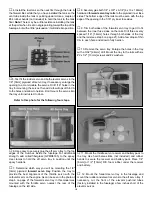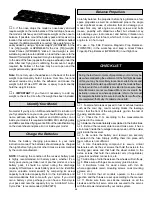
❏
12. Secure connections between servo wires and
Y-connectors or servo extensions and the connection
between the battery pack and the on/off switch with vinyl tape,
heat shrink tubing or special clips suitable for that purpose.
❏
13. Make sure servo wires do not interfere with other
systems (servo arms, pushrods, etc.).
❏
14. Make sure the fuel lines are connected and are
not kinked.
❏
15. Balance the propeller (and spare propellers).
❏
16. Tighten the propeller nut and spinner.
❏
17. Place your name, address, AMA number and
telephone number on or inside the model.
❏
18. Cycle the receiver battery pack (if necessary) and
make sure it is fully charged.
❏
19. If you wish to photograph the model, do so before the
first flight.
❏
20. Range check the radio when you get to the flying field.
If the engine is new, follow the engine manufacturer's
instructions to break-in the engine. After break-in, confirm
that the engine idles reliably, transitions smoothly and rapidly
to full power and maintains full power indefinitely. After you run
the engine on the model, inspect the model closely to make
sure all screws remained tight, the hinges are secure, the prop
is secure and all pushrods and connectors are secure.
Ground check the operational range of your radio before the first
flight of the day. With the transmitter antenna collapsed and the
receiver and transmitter on, you should be able to walk at least
100 feet away from the model and still have control. Have an
assistant stand by your model and, while you work the controls,
tell you what the control surfaces are doing. Repeat this test with
the engine running at various speeds with an assistant holding
the model, using hand signals to show you what is happening. If
the control surfaces do not respond correctly, do not fly! Find
and correct the problem first. Look for loose servo connections
or broken wires, corroded wires on old servo connectors, poor
solder joints in your battery pack or a defective cell, or a
damaged receiver crystal from a previous crash.
Keep all engine fuel in a safe place, away from high heat,
sparks or flames, as fuel is very flammable. Do not smoke
near the engine or fuel; and remember that engine exhaust
gives off a great deal of deadly carbon monoxide. Therefore
do not run the engine in a closed room or garage.
Get help from an experienced pilot when learning to
operate engines.
Use safety glasses when starting or running engines.
Do not run the engine in an area of loose gravel or sand; the
propeller may throw such material in your face or eyes.
Keep your face and body as well as all spectators away from the
plane of rotation of the propeller as you start and run the engine.
Keep these items away from the prop: loose clothing, shirt
sleeves, ties, scarves, long hair or loose objects such as
pencils or screwdrivers that may fall out of shirt or jacket
pockets into the prop.
Use a “chicken stick” or electric starter to start the engine.
Do not use your fingers to flip the propeller. Make certain the
glow plug clip or connector is secure so that it will not pop
off or otherwise get into the running propeller.
Make all engine adjustments from behind the rotating propeller.
The engine gets hot! Do not touch it during or right after
operation. Make sure fuel lines are in good condition so fuel
will not leak onto a hot engine, causing a fire.
To stop a glow engine, cut off the fuel supply by closing
off the fuel line or following the engine manufacturer's
recommendations. Do not use hands, fingers or any other body
part to try to stop the engine. To stop a gasoline powered
engine, an on/off switch should be connected to the engine coil.
Do not throw anything into the propeller of a running engine.
Read and abide by the following Academy of Model
Aeronautics Official Safety Code:
1. I will not fly my model aircraft in sanctioned events, air shows,
or model flying demonstrations until it has been proven to be
airworthy by having been previously successfully flight tested.
2. I will not fly my model aircraft higher than approximately
400 feet within 3 miles of an airport without notifying the
airport operator. I will give right of way to and avoid flying in
the proximity of full scale aircraft. Where necessary an
observer shall be used to supervise flying to avoid having
models fly in the proximity of full scale aircraft.
3. Where established, I will abide by the safety rules for the
flying site I use and I will not willfully and deliberately fly my
models in a careless, reckless and/or dangerous manner.
General
AMA SAFETY CODE (EXCERPT)
Failure to follow these safety precautions may result
in severe injury to yourself and others.
ENGINE SAFETY PRECAUTIONS
Range Check
Ground Check
FINAL PREPARATIONS
30



































